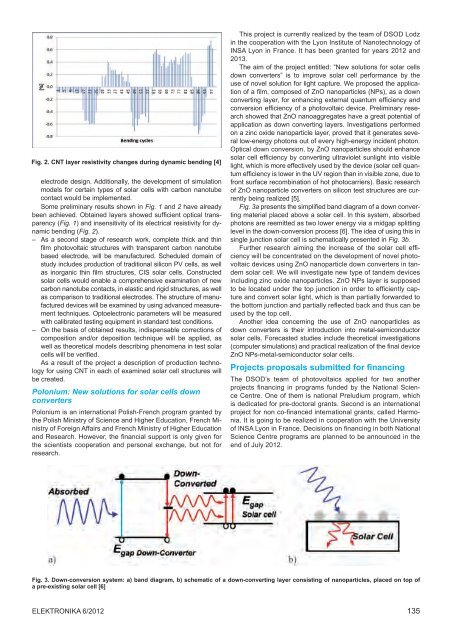Proceedings of the European Summer School of Photovoltaics 4 â 7 ...
Proceedings of the European Summer School of Photovoltaics 4 â 7 ...
Proceedings of the European Summer School of Photovoltaics 4 â 7 ...
Create successful ePaper yourself
Turn your PDF publications into a flip-book with our unique Google optimized e-Paper software.
Fig. 2. CNT layer resistivity changes during dynamic bending [4]<br />
electrode design. Additionally, <strong>the</strong> development <strong>of</strong> simulation<br />
models for certain types <strong>of</strong> solar cells with carbon nanotube<br />
contact would be implemented.<br />
Some preliminary results shown in Fig. 1 and 2 have already<br />
been achieved. Obtained layers showed sufficient optical transparency<br />
(Fig. 1) and insensitivity <strong>of</strong> its electrical resistivity for dynamic<br />
bending (Fig. 2).<br />
– As a second stage <strong>of</strong> research work, complete thick and thin<br />
film photovoltaic structures with transparent carbon nanotube<br />
based electrode, will be manufactured. Scheduled domain <strong>of</strong><br />
study includes production <strong>of</strong> traditional silicon PV cells, as well<br />
as inorganic thin film structures, CIS solar cells. Constructed<br />
solar cells would enable a comprehensive examination <strong>of</strong> new<br />
carbon nanotube contacts, in elastic and rigid structures, as well<br />
as comparison to traditional electrodes. The structure <strong>of</strong> manufactured<br />
devices will be examined by using advanced measurement<br />
techniques. Optoelectronic parameters will be measured<br />
with calibrated testing equipment in standard test conditions.<br />
– On <strong>the</strong> basis <strong>of</strong> obtained results, indispensable corrections <strong>of</strong><br />
composition and/or deposition technique will be applied, as<br />
well as <strong>the</strong>oretical models describing phenomena in test solar<br />
cells will be verified.<br />
As a result <strong>of</strong> <strong>the</strong> project a description <strong>of</strong> production technology<br />
for using CNT in each <strong>of</strong> examined solar cell structures will<br />
be created.<br />
Polonium: New solutions for solar cells down<br />
converters<br />
Polonium is an international Polish-French program granted by<br />
<strong>the</strong> Polish Ministry <strong>of</strong> Science and Higher Education, French Ministry<br />
<strong>of</strong> Foreign Affairs and French Ministry <strong>of</strong> Higher Education<br />
and Research. However, <strong>the</strong> financial support is only given for<br />
<strong>the</strong> scientists cooperation and personal exchange, but not for<br />
research.<br />
This project is currently realized by <strong>the</strong> team <strong>of</strong> DSOD Lodz<br />
in <strong>the</strong> cooperation with <strong>the</strong> Lyon Institute <strong>of</strong> Nanotechnology <strong>of</strong><br />
INSA Lyon in France. It has been granted for years 2012 and<br />
2013.<br />
The aim <strong>of</strong> <strong>the</strong> project entitled: “New solutions for solar cells<br />
down converters” is to improve solar cell performance by <strong>the</strong><br />
use <strong>of</strong> novel solution for light capture. We proposed <strong>the</strong> application<br />
<strong>of</strong> a film, composed <strong>of</strong> ZnO nanoparticles (NPs), as a down<br />
converting layer, for enhancing external quantum efficiency and<br />
conversion efficiency <strong>of</strong> a photovoltaic device. Preliminary research<br />
showed that ZnO nanoaggregates have a great potential <strong>of</strong><br />
application as down converting layers. Investigations performed<br />
on a zinc oxide nanoparticle layer, proved that it generates several<br />
low-energy photons out <strong>of</strong> every high-energy incident photon.<br />
Optical down conversion, by ZnO nanoparticles should enhance<br />
solar cell efficiency by converting ultraviolet sunlight into visible<br />
light, which is more effectively used by <strong>the</strong> device (solar cell quantum<br />
efficiency is lower in <strong>the</strong> UV region than in visible zone, due to<br />
front surface recombination <strong>of</strong> hot photocarriers). Basic research<br />
<strong>of</strong> ZnO nanoparticle converters on silicon test structures are currently<br />
being realized [5].<br />
Fig. 3a presents <strong>the</strong> simplified band diagram <strong>of</strong> a down converting<br />
material placed above a solar cell. In this system, absorbed<br />
photons are reemitted as two lower energy via a midgap splitting<br />
level in <strong>the</strong> down-conversion process [6]. The idea <strong>of</strong> using this in<br />
single junction solar cell is schematically presented in Fig. 3b.<br />
Fur<strong>the</strong>r research aiming <strong>the</strong> increase <strong>of</strong> <strong>the</strong> solar cell efficiency<br />
will be concentrated on <strong>the</strong> development <strong>of</strong> novel photovoltaic<br />
devices using ZnO nanoparticle down converters in tandem<br />
solar cell. We will investigate new type <strong>of</strong> tandem devices<br />
including zinc oxide nanoparticles. ZnO NPs layer is supposed<br />
to be located under <strong>the</strong> top junction in order to efficiently capture<br />
and convert solar light, which is than partially forwarded to<br />
<strong>the</strong> bottom junction and partially reflected back and thus can be<br />
used by <strong>the</strong> top cell.<br />
Ano<strong>the</strong>r idea concerning <strong>the</strong> use <strong>of</strong> ZnO nanoparticles as<br />
down converters is <strong>the</strong>ir introduction into metal-semiconductor<br />
solar cells. Forecasted studies include <strong>the</strong>oretical investigations<br />
(computer simulations) and practical realization <strong>of</strong> <strong>the</strong> final device<br />
ZnO NPs-metal-semiconductor solar cells.<br />
Projects proposals submitted for financing<br />
The DSOD’s team <strong>of</strong> photovoltaics applied for two ano<strong>the</strong>r<br />
projects financing in programs funded by <strong>the</strong> National Science<br />
Centre. One <strong>of</strong> <strong>the</strong>m is national Preludium program, which<br />
is dedicated for pre-doctoral grants. Second is an international<br />
project for non co-financed international grants, called Harmonia.<br />
It is going to be realized in cooperation with <strong>the</strong> University<br />
<strong>of</strong> INSA Lyon in France. Decisions on financing in both National<br />
Science Centre programs are planned to be announced in <strong>the</strong><br />
end <strong>of</strong> July 2012.<br />
Fig. 3. Down-conversion system: a) band diagram, b) schematic <strong>of</strong> a down-converting layer consisting <strong>of</strong> nanoparticles, placed on top <strong>of</strong><br />
a pre-existing solar cell [6]<br />
Elektronika 6/2012 135

















